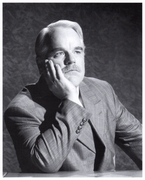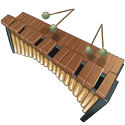|
Grain of salt as I may be misunderstanding. But unless youíre planning to play with others, you can just learn the G instructional materials on your F flute. If you do ever get a G flute, it will translate very easily. And if youíre always planning on playing alone, no one will ever know. Even people with perfect pitch would just assume youíre playing in a different key haha
|
|
|
|

|
| # ? May 10, 2024 21:20 |
|
Hawkperson posted:Grain of salt as I may be misunderstanding. But unless youíre planning to play with others, you can just learn the G instructional materials on your F flute. you are correct. the previous page seems to have a lot of misunderstanding regarding transposing instruments and concert pitch. an instrument in F sounds either a perfect fifth lower than written (like the English Horn or Wagner Tuba) or a perfect fourth higher. when you play a "C", the given pitch produced is a Concert F This generally does not affect how you read music, unless you want to play with others and you choose to sight-transpose. Most musicians who read music, especially when sight-reading, prefer to play music that's already transposed for their instrument rather than sight-transposing. But if you only want to play by yourself, it doesn't necessarily matter. Here's a primer on concert pitch, transposing instruments, and what keys most major instruments play in Hawkperson posted:If you do ever get a G flute, it will translate very easily. no. if you get a G Flute, that will sound a 4th Lower or 5th higher than concert pitch, and playing a written G Major Scale would sound like a Concert D Major Scale. webcams for christ fucked around with this message at 10:12 on Dec 27, 2022 |
|
|
|
webcams for christ posted:you are correct. the previous page seems to have a lot of misunderstanding regarding transposing instruments and concert pitch. As an example, if the first written exercise is to play the G major scale, I can simply play a F major scale and it will be the correct intervals, but not the correct notes on the page?
|
|
|
|
yep!
|
|
|
|
Great, I'll give that a try and see if I can't figure it out! Thanks, all!
|
|
|
|
Thirteen Orphans posted:As an example, if the first written exercise is to play the G major scale, I can simply play a F major scale and it will be the correct intervals, but not the correct notes on the page? almost! even easier than that, just play the G Major Scale. It will sound like a Concert C Major Scale. literally don't worry about transposing anything at all while you're getting started. also everyone watch the below video on transposing instruments. conveniently it uses the french horn as an example, which is also in F. https://youtu.be/FNT1Ze4a6cY
|
|
|
|
That dude is a pro follow on Instagram too, he is genuinely funny which is exceedingly rare among horn players. I am a horn player so I would know lol.
|
|
|
|
Can someone smarter than me explain why double sharps are a thing? Like, fine, okay, Iíll play it two half steps higher I guess, whatever. But why write F-double sharp instead of just writing G? Iím assuming it still needs to ďcountĒ as an F for a music theory reason thatís lost on me but it winds up being a G?
|
|
|
|
Yeah basically. It's pretty rare for a reason but it can show up if for example you want an augmented chord in a key with lots of sharps. F# augmented for example would be F# A# Cx (idk how people write double sharps in text, never thought of it before haha) For me personally, the most common situation I've seen it in is fast runs like in complex flute music. In cases like that it's easier to parse a run when as many of the notes as possible have unique positions on the staff. Say I had a run in a minor key with lots of sharps that included E#, Fx (G), and G#. Honestly either way it's a pain in the rear end and most editors would probably mark it as G natural, but one way displays the flow of the line a little better. Even in that case by "more common" I mean "I think I've seen it in printed music twice in the 20+ years I've been playing flute"
|
|
|
|
Xiahou Dun posted:Can someone smarter than me explain why double sharps are a thing? It's for when you're in a key with a lot of sharps (G# for example) and you want to specify that your intention as the composer/engraver/whatever is to nudge the note up a half step. If we're talking about the 7th scale degree in G# minor that'd be an F#, so since it's already sharp you now have to make it double sharp. I've been tempted to use double flats and sharps in situations like this before but then I always remember how eyeroll-worthy it is and end up just respelling the note. Hawkperson posted:For me personally, the most common situation I've seen it in is fast runs like in complex flute music. In cases like that it's easier to parse a run when as many of the notes as possible have unique positions on the staff. Say I had a run in a minor key with lots of sharps that included E#, Fx (G), and G#. Honestly either way it's a pain in the rear end and most editors would probably mark it as G natural, but one way displays the flow of the line a little better. Even in that case by "more common" I mean "I think I've seen it in printed music twice in the 20+ years I've been playing flute" Exactly right. You don't want to be constantly adding accidentals to every note if you can help it, and sometimes a double flat or sharp can help you avoid having to do that, like in a trill or a run. But still, probably better to look for another solution first. timp fucked around with this message at 04:53 on Dec 30, 2022 |
|
|
|
Thank you for the responses, they were helpful. That sounds like insanity, but thatís how I feel about 90% of music theory until I actually use it. Cool notation though. 𝄪 is unicode U+1D12A, you know, just in case you ever really need to type that properly. But personally, for ease of typing (well sort of) Iíd nominate ## It actually just got added to the library fairly recently, so Iím kind of curious what anyone on the internet used before a couple years ago.
|
|
|
|
I draw an x when I'm notating by hand. Also to bring it back to the last topic, when you're composing something for a an orchestra it large ensemble, individual parts eventually have to be transposed so they're all at concert pitch, and you may end up with double sharps or double flats that way
|
|
|
|
Which type of microphone should I get for recording acoustic guitar and speech? Any recs?
|
|
|
|
The Aston Element is insanely good for the price and very versatile for instruments, just gotta be careful about the proximity effect for speech, it does more of that bass boost than most
|
|
|
|
Is there a quick way to convert midi to guitar tablature? I could transcribe it by hand of course, but if there's an already existing solution that'd make things quicker.
|
|
|
|
InternetOfTwinks posted:Is there a quick way to convert midi to guitar tablature? I could transcribe it by hand of course, but if there's an already existing solution that'd make things quicker. import it into a notation software. the sheet music will be hot garbage but the tabs should be fine. musescore is free, or sibelius is like 12$/mo
|
|
|
|
Huh, I would have assumed the opposite since there's so many different places you can play most notes on a guitar. I'll give MuseScore a shot, thanks!
|
|
|
|
Ruffian Price posted:The Aston Element is insanely good for the price and very versatile for instruments, just gotta be careful about the proximity effect for speech, it does more of that bass boost than most Thanks for that. I ended up finding an almost unused Origin for about half the price of a new one.
|
|
|
|
its not really a small question but I thought it would be a good place to start. This is going to be a bit of a ramble as im kinda nervous, these may be really dumb questions. Since Christmas ive been getting lots of entertainment and just plain fun out of making parody songs. I basically listen to the song about a billion times and write the words as i see fit, making sure to match the cadence and rhythms of the original while still having my own twist on it. I dont have a lot of high end tools, i use a chrome extension to rip the audio from youtube music, then i have an app on my phone called unMix that splits the track up. I then upload everything but the vocals to Soundtrap (this is my DAW as ive learned its called) because i have a very weak chromebook and soundtrap is the one thing i have found that i can use in my browser to record From there I use an USB Condenser mic i got on amazon and then sing my silly words to the instrumental track i have created. I am getting an isolation screen for my mic but currently i sing either in my closet or with a big ole blanket over my head The thing is It does not sound properly enmeshed (?) into the instrumental track. It's the vocal equivalent of writing over the liner notes with my own lyrics, in big permanent marker. it's there but it feels weird, kinda fits and while maybe catchy isn't what it should be. I have no real experience in mixing music like this and when ive asked for help ppl say things like "High pass EQ to eliminate rumble and reduce low-mid mud" or "add compression (maybe even and a "presence" boost with EQ (around 2.5k)" and that does not make a lick of sense to me.  The DAW does have an equalizer and i have messed with some of those settings im wondering if there is a really simple guide to what all that means, whats a gain? i messed with "tone" and it sounds different when i twist it, but why? I guess the short version is i just dont know how to match the EQ of my vocals to the EQ of the instrumental track. Do i need a louder instrumental track and raise my vocals to meet that? i just dunno how to do it. Beer_Suitcase fucked around with this message at 01:04 on Feb 4, 2023 |
|
|
|
I'm not an expert at mixing either, surely someone on the forum knows more about this than i do. And it's hard to know what you mean without hearing it... Nevertheless, here's my guess: if it's hard to get the right volume for each track, maybe it's because there are large swings in volume? if that's the problem, then maybe try a Compressor effect or a Limiter effect on each track?
|
|
|
|
I'm no audio expert, but the first thing that came to my mind is that if your voice audio is really dry (this is a sound tech term, basically meaning that it's a clean recording with no echo/noise/effects) and the rest of the music has reverb or other effects applied to it, then your vocal audio is going to sound out of place. You should try to figure out what kind of settings the producer used on the music, and match those settings as closely as possible. Those settings were used to create a particular sense of place (in particular in terms of room size and reverberance), so it's no wonder that your own audio sounds wrong when layered over that.
|
|
|
|
So this is my latest one https://www.youtube.com/watch?v=zXE33RDjMtg I may just have overly critical ears but to me it sounds like my vocals are just out of sorts. i really heard it on this one https://www.youtube.com/watch?v=O72AeSB4p1c My new song is a parody of Blink182's "rock show" and my isolation shield is coming tomorrow. so I can make a scratch track and go from there. I just dont know if i should sing loud, or sing comfortably and then make it loud later
|
|
|
|
yeah, especially in professional pop music, the vocals are likely going to be processed pretty heavily, even if it's fairly transparent when placed in the final track. that's usually some combination of compression and equalization, and even manual volume leveling via automation (which is kinda like compression, just more detailed because it's manual). all of that will be with the express purpose of sitting alongside the instrumental track. you also might be fighting with the instrumental a bit because youtube (and maybe unmix?) are going to get rid of a lot of theoretically unneeded information, so you're doing the equivalent of photoshopping a high res raw photo into a low res jpg. you're definitely right that it's a big question, but it's certainly not a dumb one. gotta start somewhere, right? to answer your two direct lines of questioning: EQ: the sound you're hearing is made up of a bunch of different frequencies occurring together. depending on the source and the way it was recorded, some parts of the frequency spectrum are going to be emphasized more than others. the two types of equalizer you have in the picture, as well as the tone knob, all control how those are emphasized. tone one in the bottom middle is probably the best visual explanation of it in your screenshot: each of those little sliders is attached to a frequency, and has a certain width before you get to the next slider, and pulling that up or down changes the gain for each individual segment. that equalizer is good for making surgical adjustments around problem frequencies, but not as good at making overall adjustments. the parametric eq does the same thing, except you get to choose the width (sometimes called Q, although on yours it's just the furthest right knob that has the \__/ and V next to it) and center frequency (your furthest left knob), and so is very customizable and useful for bigger changes. gain is just how much you're adding or taking away from the volume in the particular area that you've defined with width and frequency. the tone knob is an even more simplified version of all that, and though they can work in different ways, probably the most common way is that it has what's called a high shelf (so instead of a little bump with other sliders on either side, it just raises or lowers everything above a particular frequency). with those tools, you can add or take away frequencies to emphasize different parts of that track. which parts is the hard question, and kind of unanswerable without hearing what you're working on, because it depends on what sounds you have and what ones you're trying to match. it's pretty easy to overdo these adjustments, so if things just sound terrible, it can be worth it to start over and make different, more subtle adjustments. Volume: you're almost certainly going to need a compressor, which squishes down the loudest parts of a track so they're closer in volume to the quiet parts. that might sound counterintuitive, but having extra headroom means you can use makeup gain to raise the volume of the entire track, making your previously quiet parts loud enough to hear. it also has some side effects that are kinda complicated, and tbh it took me about 10 years to get comfortable with compression because it's a deceptively simple idea with a lot of nuance and complexity to it. to start, i'd just see if your DAW has a compressor with a vocal preset. the compressor should have a Gain Reduction meter on it, and you'll want to set your threshold so that you see some gain reduction on the loud parts, but not on the quiet parts. it's easy to overdo it, but also relatively easy to hear when you do (it'll just sound wrong and make your head feel like it's turning inside out if you compress it too much). it's also pretty common to add a little splash of reverb to the vocals, but that's yet another thing it's easy to overdo. when i'm mixing vocals, i start out by turning the reverb down to the point where i just barely can't hear it anymore, and adjust from there. but don't spend too long on it, because your brain is exquisite in its ability to filter out reverberations, so you might find yourself turning the reverb up and up and up as you work on it, then coming back later and realizing you've made it sound like you're in a cave. hopefully that answers at least some of your questions, and if you're comfortable posting some examples we can give much more detailed advice tailored to your specific project! edit: lol i spent so long writing this i missed the other posts CaptainViolence fucked around with this message at 02:25 on Feb 4, 2023 |
|
|
|
Thanks so much for helping me understand how to better use my the tools in my DAW. I'll be putting together the song this weekend and I'll be trying some of the tips suggested re: compression/limiter, and I do learn new things with every song I get finished I just felt I was hitting a wall. I've always been a "do it first" and figure it out later kinda guy, also it's fun to have a song come on the radio and your kiddo sings your version not the original
|
|
|
|
This was really cool and informative to read, thanks yíall for breaking it down so well
|
|
|
|
CaptainViolence posted:that equalizer is good for making surgical adjustments around problem frequencies, but not as good at making overall adjustments. What is a problem frequency?
|
|
|
|
Pollyanna posted:What is a problem frequency? 666 Hz
|
|
|
|
Sweaty IT Nerd posted:666 Hz lol Pollyanna posted:What is a problem frequency? basically any frequency that causes a problem  i know that's not super specific, but like everything we're talking about, it really depends on the source material and what that's being mixed into. it can be something that emphasizes a boxy sound, or a nasally vocal, or just two instruments overlapping each other in such a way that some part of the spectrum gets muddied up and both become indistinct. i know that's not super specific, but like everything we're talking about, it really depends on the source material and what that's being mixed into. it can be something that emphasizes a boxy sound, or a nasally vocal, or just two instruments overlapping each other in such a way that some part of the spectrum gets muddied up and both become indistinct.i guess maybe i can explain it in terms of how i run into and deal with it every day, and maybe that will make more sense? my day job involves a lot of dialogue mixing for educational videos. usually no bed music, sound design only under animations, pretty simple stuff overall. but, not having anything else to hide behind, sometimes that lets things show through that might be hidden otherwise. our main studio is acoustically treated, so we don't have a lot of high end reflections or reverb to deal with, but the studio was also not built as a studio so the ceilings are kinda low. i use a specific mic placed to reject as much ceiling reflection as possible without getting into frame, but because the pickup pattern is wider you end up with a little bit more of that room sound in the low end. also, there's a street outside, and low-frequency rumble from trucks driving by is not uncommon. what happens is i end up with a couple different problem frequencies: that boomy, boxy sound is from a buildup around the 350 Hz zone, so i cut out 4-5db with a Q of 1-4 (depending on which host, because each of their voices is different). additionally, i have a low-cut sitting somewhere between 60 and 80 Hz to cut out those truck rumbles. i use the waves ssl e-channel for both compression and eq, so it has a set slope of 18db/oct, which is decently steep, so i don't have to set it too high. if it's ever a problem enough that i need a more detailed eq pass, i'll usually set the slope in a separate dedicated parametric eq to 48db/oct, and keep it between 30 and 60 Hz. i came up with those numbers just by getting to know the material and space and figuring out what frequencies were making the weird qualities i was trying to get rid of, and also which ones i needed to not touchóif i bring that low cut up too far, it starts affecting the host's voice, which i don't want. if those adjustments are too large or contain too many frequencies, you start getting rid of frequencies that aren't causing the problems you're hearing, which creates new problems. there's cheat sheets all over the place that list where common problems show up in the frequency spectrum (that's originally what i referenced to start looking for my boxy frequency), and they're a good starting point as long as you only use them as a starting point and not a bible. i think one of the best tricks someone ever showed me was that if you set up a really extreme parametric eq notch (so, like, Q≈10-15 adding 15ish db), you can sweep it around the frequency spectrum to hear what it's going to be emphasizing. your actual adjustment is probably never going to be that extreme, but if you pass it through a frequency and suddenly hear a ton of whatever it is you hate, you know where to put a cut! Beer_Suitcase posted:i really heard it on this one cool! i am definitely hearing what you're talking about now, and i think you're probably fighting the recording in mixing. you've got distortion on your voice, but it sounds like digital distortion from having your recording gain too high and clipping the input signal. part of that is that it happens only when you're singing loudly and not quietly, so if it is on purpose it might be helpful to make that more consistent or at least pick and choose moments so that it sounds planned instead of just reacting to however you were singing. if it isn't on purpose, just turn your gain down when recording! it'll sound quiet until you mix it, but you can alleviate that by also turning the instrumental down and turning your headphones up. then you can do some of that compressor stuff we talked about to make your voice loud enough to match the full volume backing track. another part of what makes it sound like clipping instead of intentional distortion is that the distortion is very brittle, with a lot of emphasis on the high frequencies. to bring it back to the tone knob idea, the instrumental sounds like the tone is set in the middle or even a little more toward the bassy end, whereas your voice sounds like it's cranked to almost full treble. that combined with the uneven volume levels keeps your voice and the backing track from sounding integrated. the third part i'm noticing is that even when there's no distortion, your voice has a very "USB condenser" quality to it, which can somewhat be alleviated with eq, but not entirely. it's just not picking up a lot of the low end of your voice, and the high end lacks a lot of detail. if you're not looking to buy an interface and better mic, it might be worth looking for a USB dynamic mic (assuming they even make them, i've never checked.) dynamic mics have what's called the proximity effect, where the closer you are to the mic the better the bass response, which is how radio hosts get that cool, deep sound. you probably don't want to go full NPR nerd, but you'd be aiming for something in the middle of that and what you have now. if you stick with this mic, i would try emphasizing the low end with big, wide eq boosts combined with some notched eq cuts to get rid of any boxiness you add with the boost. you might also try duplicating the vocal track, putting a high cut on to get rid of the high end, then adding saturation/distortion to emphasize those low parts you're missing, and mixing that back in with the main vocal track to try to balance it out. i don't know how far you'll be able to push that mic, but the isolation shield you got should help clarify the midrange a bit. be warned, though, some of those shields (especially cheaper ones) add in weird reflections and interference that sounds kind of like a comb filter, so it may end up solving some of your problems while creating new ones. and finally, i think you have a better handle on the mixing than you think! the way you brought in the reverb for the choruses of enclosure sounds like it would fit wonderfully if the recording quality of the mic were better. my initial impression is definitely that you are fighting the mic more than anything. i'm interested to hear if anyone else has any ideas for how to approach itómy go-to for usb mics has always been to lean into the lofi feeling and saturate the hell out of them, so i don't have a lot of experience trying to match them to a song that doesn't call for that.
|
|
|
|
I don't know if it is because of a technical issue, but my feeling is the vocals are just a fraction late all around. I often have to adjust (parts of) my recordings to better match the beat. Mostly forwards, despite automatic latency compensation and whatnot. I don't know if that's because of singing in reaction to the music or having to think to hard about the words or whatever. In any case, don't be afraid to slice things up, nudge things around by 10ms increments to see if it happen to mesh together better rhythmically. This is a thing that can also help the listener's suspension of disbelief that your voice belongs with the music.
|
|
|
|
Can anybody help me understand what's going on with the vocal harmonies in the chorus here, specifically the "Don't allow" "Kyoto now" parts? https://www.youtube.com/watch?v=LzMG5WjXcy0&t=102s I always have a hard time hearing the distinct notes in a vocal harmony but this sounds like something more complicated than a standard third-based structure.
|
|
|
|
Lester Shy posted:Can anybody help me understand what's going on with the vocal harmonies in the chorus here, specifically the "Don't allow" "Kyoto now" parts? Sounds like parallel fourths to me! If I'm right tha on the bottom is an A going up to a B, and on top is a D going up to an E. Edit: I'm using my rusty-rear end perfect pitch to call out those notes, but it's possible I may be flat or sharp by a half-step. But the intervals will remain; two perfect fourths.
|
|
|
|
Lester Shy posted:Can anybody help me understand what's going on with the vocal harmonies in the chorus here, specifically the "Don't allow" "Kyoto now" parts? I'd have to sit down at my piano to work it out exactly, but it sounds like those small sections are run through something like Polyvox: https://www.youtube.com/watch?v=CwgaZcXbjqU the voicing is what I'd call a "close harmony" and it sounds like some of the parts are a major 2nd apart from each other, like an inverted 9th chord
|
|
|
|
So the harmony is doing parellel fourths for "Don't allow" and "Kyoto Now", Ab (don't/Kyo) in the lower voice to Bb (allow/-to now) and Db in the upper voice to Eb, over top of what I think is Bb5 Db5 Ab5 Eb5 in the guitar and bass. The lead vocal is also doubling the Db to Eb in the same range for both of those parts. When it goes to "In your dreams" it's more complex due to the lead vocal sitting between the C and Db a bunch. The upper harmony is possibly going C (In) Db (your) Eb (dreams) and the lead is doing C (In) - Db (your dreams) and back down to C (-ams) and maybe down to Bb. Definitely a bit of a fall there. I'm not 100% certain on this as the harmony might've been recorded the same for all of these takes but I don't really hear a minor 2nd interval at first. code:For the "Silent scream" the harmony is back to the first one for sure lower Ab-Bb and upper Db-Eb, while the lead is doing Db-C-Bb down. It is closed voiced which makes it hard to tell which voice is doing what, like the lead might be doing a fall down from C to Bb in the In Your Dreams part but the harmony is also doing a Bb so I might be mishearing it.
|
|
|
|
Iíve got about $200 to burn. I wanna spend it on my music hobby, specifically making music. Ideally Iíd like to invest in my music-making abilities and experience, and in streamlining my music-making process. I donít need hardware synthesizers and Iím sitting relatively pretty on software (Renoise for my DAW, various free softsynths and effects for VSTs). As someone who wants to make music and get better at making music, what is this money best spent on?
|
|
|
|
Kontakt? There is so much free poo poo that requires a full version of Kontakt
|
|
|
|
Pollyanna posted:Iíve got about $200 to burn. I wanna spend it on my music hobby, specifically making music. Ideally Iíd like to invest in my music-making abilities and experience, and in streamlining my music-making process. I donít need hardware synthesizers and Iím sitting relatively pretty on software (Renoise for my DAW, various free softsynths and effects for VSTs). one strategy is to put the money on the line against a discrete goal with a deadline. something really ambitious would be entering some sort competition with a jury. for example the Musicworks Electronic Music Composition Contest getting a fire lit under your rear end is worth far more than any piece of equipment or software
|
|
|
|
Ideally Iíd like to quit my job and focus on music and actually get my executive dysfunctional rear end into some goddamn structure and organization, but that costs way more than $200.  I guess that means instruments and voices arenít high priority, so theory and praxis e.g. that competition dead pool idea would be better investments. Maybe Iíll take a class? Buy a book or two?
|
|
|
|
Maybe buy some tutoring from a producer you enjoy. Like make a track and they'll dissect it for you and offer pointers. Nothing teaches like having something you love get dismantled. 
|
|
|
|
Problem #1 is that Iíd want to bring a serious project to them (e: and understand what I want to make), so thatíll need to be done first. Problem #2 is oh god people. Maybe thatís my motivation to finish those drat projects. Would be an interesting gimmick for a double album, a before/after  Oh, or classes/tutoring on the composition and production workflow. Thatíd help a lot, structure and organization are some of my biggest missing pieces. Pollyanna fucked around with this message at 18:47 on Feb 23, 2023 |
|
|
|

|
| # ? May 10, 2024 21:20 |
|
Pollyanna posted:Ideally Iíd like to quit my job and focus on music and actually get my executive dysfunctional rear end into some goddamn structure and organization, but that costs way more than $200. Just to check, are you hoping to make money as a musician?
|
|
|






























